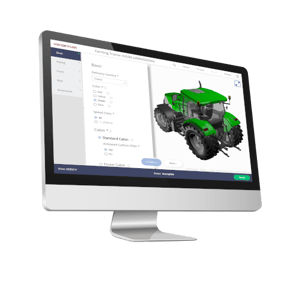It’s very typical that people mix up the meaning of "configure", "configurator" and even "configuration". We can be easily talking about "configure" when we actually mean "configurator" or "configuration" and vice versa.
Way too often we are talking too widely when we should stick to "configure", "configuration" or "configuration". Since these ‘boxes’ of terminology are not always clear enough for us, we thought it is good time to refresh the idea behind these terms.

What does "configure" mean?
One could say “let’s configure this”. The act of configuring specifies an individual product that takes into account customer needs and the possibilities of the product. Configuring can include typing the customer needs to the configurator or any other system like Excel.
In a bit more contextual world “Configure” is the way to work and process that helps us to handle unique needs of our products and services. The output from this process is the specification of a needed solution.
What does "configurator" mean then?
A configurator is an information system that on one hand models product parameters and rules of a configurable product, service or solution in a configuration model. On the other hand, it helps user to configure products, services and solutions.
"Configurator" might mean a complete tool with a configuration model, user interface etc. and it also could be just the “configurator engine” that is meant to manage numerous configurable products of different companies.
And what does "configuration" mean?
A configuration is version of a configured product or solution. Configurations can be on different level of detail. For example, a sales configuration is more abstract and compact than a detailed as-delivered configuration. Once a product is delivered, its configuration becomes part of the installed base. To support service operations, it is important to maintain installed base configurations up to date through configuration management and change management.
In Variantum’s VariSuite there are four main Configuration areas: PDM, CPQ, BOM generator and Traceability / Installed base
PDM for complex configurable products
Within VariSuite's PDM capabilities we are handling product information during design. Part of the design is typically fixed and part of it is configurable and necessary development process steps, rules, restriction, and relationships are managed with PDM. This helps us for manufacturing and/or delivering the configured solutions.
Engineering configuration makes sure that we are not skipping those possible needs that require manual human touch during the production phase since not everything is possible to automate by robots and for example some soft adjustments might require human engineering during the production phase.
CPQ for complex pricing, quoting and visualization
When we are talking with the Customer about their new need and the corresponding setup of our offering, we’re creating the sales configuration for our offer.
The VariSuite's CPQ uses current product data, structures, configuration rules, and prices. This makes it sure that no matter what combination of available products and options is sold, we’re able to deliver it.
With CPQ features we can also visualize offered customer solution with real time 3D model for better understanding of the offered product and to improve the customer experience.
Automate order specific BOM and document configuration
At this phase we are producing the manufacturing structure based on order parameters together with deep knowledge coming from Product Data Management configuration and making sure our ERP knows all the needed materials and our factories knows when we should produce and what exactly to whom.
Trace, maintain and analyze configuration data of installed base
This is one of the key steps especially in future – we need to know what we have sold, to whom and when, and of course, if there has being any maintenance yet for the delivered product or service. We need to keep up how the entity of “offering” is being changed during its lifecycle. Why it’s important? We need to know when Customer needs the repair or maintenance, when they could get newer and better version of the product and so on. Needs for tracing your sold and produced items are unlimited. The Trace makes sure your maintenance staff gets the up to date and relevant data of the current product in maintenance the way that is optimal for the users. With IOT capabilities you are able to connect current product data with measured IOT data. VariSuite's Trace / installed base enables analyzing after sales possibilities for example modernization or service parts or replacements.